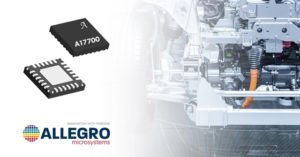 Allegro MicroSystems, Inc., a global provider of sensing and power solutions for motion control and energy-efficient systems, has introduced the A17700 — an automotive-grade interface IC for resistive bridge pressure sensors featuring top-of-the-line signal conditioning algorithms.
Allegro MicroSystems, Inc., a global provider of sensing and power solutions for motion control and energy-efficient systems, has introduced the A17700 — an automotive-grade interface IC for resistive bridge pressure sensors featuring top-of-the-line signal conditioning algorithms.
Built on decades of automotive sensor expertise, the A17700 delivers premium performance and increased system efficiency with flexible interface options, all in a small form factor.
Features include:
- Flexible compensation algorithms for accuracy over temperature and sensing bridge variation;
- Precise pressure information delivery in low-delay analog, PWM, or SENT outputs;
- Automotive AEC-Q100 Grade 0 qualification and EMC robustness with minimized external components;
- A suite of advanced integrated system diagnostics.
The A17700 is configurable for resistive bridge pressure sensors in a wide range of critical applications in today’s efficiently designed cars — from high-pressure systems like dynamic brake systems (DBS) in turbo and hybrid electric vehicles (HEV) or gasoline direct injection (GDI) to medium and low-pressure systems such as brake boosters, HVAC applications for electrified vehicles, and automatic transmission oil management.
High accuracy output
With its best-in-class integrated polynomial algorithm, the A17700 interface sensor offers high accuracy over-pressure and temperature through two-stage processing of a pressure signal. This flexible compensation delivers high accuracy in resistive membranes requiring either high- or low-point characterization during assembly.
Striking a balance highly desired by system designers, this device offers ways to improve system output and maintain flexibility. With robust EMC performance – up to 4kV HBM – the A17700 also enables up to 30% fewer external components for a smaller total solution footprint, smaller PCB, and more cost-efficient system design.
“The A17700 allows system designers to easily select the optimal algorithm and I/O options that best fit their system requirements, balancing accuracy and end-of-line test times, thereby optimizing the system cost,” explains Haeyoung Choi, product manager for Sensor Interface ICs at Allegro. “With its small footprint and flexible compensation, the A17700 is the ideal solution for applications where space and efficiency matter, like in today’s electric and hybrid electric vehicles.”
Fast output response
With parallel processing paths for input and temperature, the A17700 can achieve the smallest chip delay on the market. With an input-to-output processing delay of 100 μs, this ultra-fast interface sensing IC allows systems to compensate for vibration effects on the membrane with no output resolution loss, further increasing system fidelity.
“This fast device response time enables faster output sampling that allows undesired membrane oscillations to be filtered by the system,” adds Choi. “This enhanced ability to report the oscillations will confirm that the appropriate filtering is applied and offer customers trusted reliability and performance.”
Diagnostics for safety
Environmental conditions, such as a change in supply voltage level, temperature, input bridge signal, and connection, can cause temporary faults in pressure sensing systems. The A17700 captures these changes and signals them in the output protocol, enabling fault filtering at the system level for more accurate safety notifications.
The A17700 is available in a small form-factor 24-pin 4 mm × 4 mm QFN package with wettable flanks, which are ideal for ensuring reliable soldering and visual inspection of solder joints.
Filed Under: Components, News


Questions related to this article?
👉Ask and discuss on Electro-Tech-Online.com and EDAboard.com forums.
Tell Us What You Think!!
You must be logged in to post a comment.